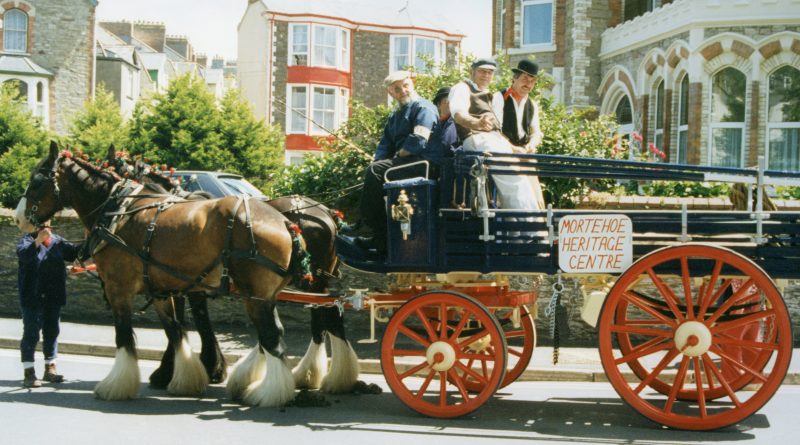Coastguard and Rocket Apparatus
| Woolacombe and Mortehoe’s coastline have had many shipwrecks over the years. The coastguards have played an important role in protecting the people that found themseles in trouble.
The first records of the rocket apparatus at Woolacombe are incomplete, however the first entry in the Rocket Apparatus Records book is dated 1890, and details a wreck that happened on June 23rd at 03:00 in the morning. At this time there were only two coastguards and a team of eighteen volunteers. A mounted messenger would be sent to Ilfracombe to notifty the Divisional Officer and a signal was fired to notify and summon the team to assist. The horses would then be fetched from North Morte Farm to pull the equipment along the cliff top and towards the ship that was in distress. The Rocket Apparatus was first developed by Henry Trengrouse, who on witnessing a shipwreck and the loss of over 100 people’s lives, decided to dedicate his life to developing a means of saving the lives of those who had been shipwrecked. Henry would spend many years, developing many ideas, the rocket apparatus would be an early form of the late Breeches Buoy and would go on to be used by many coastguards. The rocket apparatus used a firing rocket that went over to the shipwrecked vessel, then a chain was used to remove any crew and passengers by a chair one by one. One of the lines was attached to a mobile pole in a cart which would often be pulled by men or horses and the other was attached to the ship. The Mortehoe coastguard consisted of 20 men until 1950s, they would use their rocket apparatus on many occasions to save the lives of those who became shipwrecked along the coastline, they had four practices a year, whereby the coastguard team would take two carthorse out onto Morte Field, which pulled the rocket apparatus along, the practice lasting about two hours was a big occasion. The rocket apparatus team would have a day and evening practice, and at the time with only a hurricane lamp for the evening practice conditions were hazardous and required volunteers who knew the terrain and local environment well. Ray Easterbrook in his book ‘My life in Morte’ described later events as “ a rocket was fired, pulling a line across the rocket pole (which represented the ships mast), the hauser was then pulled across by men representing the ship’s crew, and a ‘breeches-buoy’ was hauled across to bring back imaginary shipwrecked mariners. For this drill, men were paid half a crown 2/6d. The coastguard in those days did not do cliff rescue only shipwrecks. Thomas Parker served as a member of the crew of the old Woolacombe Lifeboat. During the great war he served his country as a coastwatcher at the look out station near Mortehoe and a tablet paying tribute to his efficiency and fine service was erected at the station by the late Mr Pickering of the Castle, Woolacombe. He was also the holder of a silver medal, awarded by the Board of Trade for his long service in connection with the rocket life saving apparatus. There have been many accounts of how the Rocket Apparatus saved lives on the Woolacombe & Mortehoe Coastline, here are just a few: Friday 26th January 1894 – Heroic conduct of a coastguard Just before noon a message was received by the Coastguard that a French Brig, ACL had become shipwrecked. During the fog in the night she had run on to Woolacombe Sands, and at daybreak the crew were seen making signals of distress. The local coastguards deployed the rocket apparatus to the shore and after some difficulty threw a line over the vessel and succeeded in rescuing the crew. The master preferred to stay on board. The vessel was heading to Cardiff from Bordeaux. Thursday 13th January 1916 In exceptionally boisterous weather, the steamer “Newtown’ (bound from Oporto, Portugal to Newport, Monmouth with a cargo of pitwood) ran aground on Barricane Rocks. Captain Rees, of Cardiff (who was in command of the ship) and a crew of eighteen hands were rescued amid exciting scenes by the rocket apparatus. Distress flares had first been noticed shortly after 2am, and Mr John Dyer, the Coastwatcher, at once notified the lifeboat authorities. Mr Dyer next promptly proceded to the point nearest the distressed vessel with the rocket apparatus, having very soon the assistance of a most willing band of helpers. Three attemps were made to fire the rocket apparatus, in the first two the line was carried away by the wind over the masts of the vessel, but the third was more successful, the line being secured to the steamer. The crew made up of, eight Englishmen, including a lad of sixteen who was making his first voyage, one Dutchman, three Russians, five Arabs and one Maltese all made it to land safely. |









